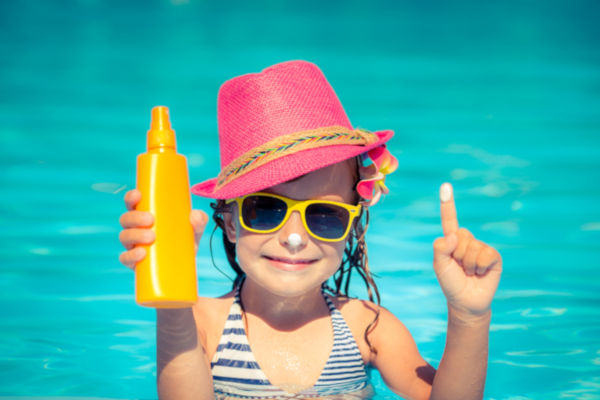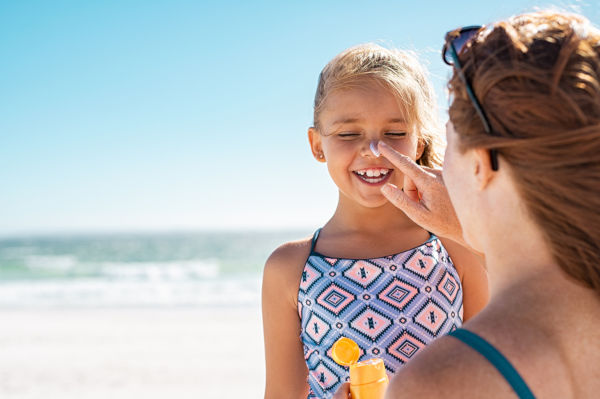Here at Mumblog, we love the sunshine. Trips to the park straight after school burn off excess energy, and weekends hanging out with friends and firing up the BBQ are the stuff that memories are made of. Plus, we get to eat all our meals outdoors and for those of us who have kids that are messy eaters, this means there is far less cleaning up to do!
However, there is a downside to all that sunshine, and that’s the risk of sunburn. We all dread the daily battle that comes with applying sun cream to a wriggling toddler desperate to escape, but it’s a necessary part of the day, being vital to your child’s health. So, before you bask out in the sun, check out our tips for keeping your child sun safe this summer.
Myths About Sun Protection

Before we look at how you can keep your child sun safe this summer, let’s take a look at some of the common myths about sun protection, as some of these “beliefs” can have dangerous consequences!
Myth 1: You Can’t Burn When It’s Cloudy
UV radiation that comes from the sun can cause skin cancer, and what’s more, it can penetrate through clouds, meaning that you can still damage your skin even on a cloudy day. The best way to check if you are at risk is to keep an eye on the UV index forecast. Cancer Research UK recommends using sun protection if the index is 3 or above.
Myth 2: A Tan Will Protect Me From The Sun
Sadly, your skin’s “sun-kissed glow” will come at a price. If your body has started to tan, that means that UV rays have penetrated your skin, triggering your body’s defence mechanisms against the sun. In other words, think of your body as a fortress, and the shield carrying knights as your “tan”. The knights are asleep inside the fortress, until one day, invaders (the UV radiation) come and start climbing over the fortress’s walls. By the time the knights wake up and get into position, the invaders have already wreaked havoc around the fortress. In the same way, by the time your body has developed a tan, exposure to UV radiation has already caused damage to your DNA.
Not only that, but studies have shown that the tan offers very little protection against the sun, being the equivalent of sun protection factor (SPF) 3 sun cream, which is not enough to keep you safe. Furthermore, tanning is also associated with premature aging. So, ditch the tan and embrace that pale skin, knowing it’s far healthier.
Myth 3: Children Need To Be Exposed To The Sun As Much As Possible To Get Vitamin D
Whilst it is true that your body generates Vitamin D from the sun’s rays, and that this vitamin is vital for your child’s health, it is not the case that you need prolonged exposure to produce enough of the nutrient. As a very rough guide, you can get enough vitamin D by spending around 10 minutes outside between 11am and 3pm with your arms and face uncovered and with no sun protection each day. Of course, this varies from person to person and it’s important to note that very pale children are at increased risk of burning, even with short exposure to the sun. Once your body has made enough vitamin D for the day, it starts to break down any extra that is generated. You can’t “bank” vitamin D as it were, so staying out for longer with exposed skin does not help your child get any more.
Myth 4: The Higher The SPF Rating, The Longer My Child Can Stay Out In The Sun
There is actually very little difference in the protection offered by SPF 15 and SPF 50 sun cream, so long as you apply the cream correctly, using plenty to cover all exposed areas, and re-applying it after two hours of exposure and immediately after swimming or sweating.
Some studies have shown that people who used SPF 50 are more at risk of skin damage because they become more relaxed about re-applying and over-estimate how much protection it offers. Most experts agree that if applied correctly, a sun cream with SPF 15 and a UVA star rating of 4 or 5 is adequate, providing you follow the advice above regarding re-application.
Myth 5: Getting Sunburnt Occasionally Won’t Do Any Long Term Damage
Sadly, this is not true, as research has show that just getting burnt once every two years can triple your risk of developing melanoma. Furthermore, it’s especially important to keep children safe as too much exposure to the sun for children under 10 years old can double their chances of developing skin cancer in later life. Therefore, it’s important to take steps to reduce your child’s risk of sun damage whenever possible.
Top Tips For Keeping Your Child Sun Safe This Summer

It isn’t all about the sun cream (though that is important), as there are lots of other ways you can keep your child sun safe this summer.
1. Use The Right Sun Cream & Plenty Of It
You should look for a sun cream that offers both UVA and UVB protection. UVA and UVB are two types of radiation that come from the sun, and both types can cause skin cancer and sun burn, whilst UVA rays also cause skin aging. The sun cream’s UVB protection can be identified from the SPF rating. Look for one that has a rating of SPF 15 and above. The UVA protection level is identified through a star rating, and you should use a cream that has a star rating of 4 or 5.
You need to use a lot more sun cream than you think to ensure proper protection. For adults, the recommended amount is around 6-8 teaspoons. There’s no set amount for children, as they vary in size, but make sure that you applying plenty of it, especially in areas that are often missed, such as the back of the neck and ears.
You should apply the sun cream around 30 minutes before going out in the sun, and reapply after two hours, again, using plenty. You should also reapply sun cream after being in water, or sweating lots after an activity.
What About All Day Sun Cream? Does It Work?
There are several products on the market that claim to offer all day protection against the sun’s rays. However, a study by Which? demonstrated that the protection offered by these creams reduced by 74%. It’s worth noting that whilst the manufacturers dispute this research, they are forbidden from claiming that the sun cream only needs applying “once a day” in Australia, where the government takes the risk of skin cancer very seriously.
That being said, these creams do have their uses. If your child is going to school on a sunny day, and your school refuses to help reapply sun cream, then using these all-day creams can offer you some peace of mind, especially if your child is not capable or reliable enough to reapply sun cream themselves. Just make sure that when you pick your child up after school you reapply sun cream before heading to the park or letting them play in the garden.
2. Avoid The Sun In The Middle Of The Day
The sun’s rays are the strongest between 11am and 3pm, so during that time it’s wise to keep to shaded areas or inside. If you are heading out for the day then take a parasol or a beach tent / shelter to provide yourselves with some much needed shade.
3. Keep Babies Out Of Sunlight
Babies under six months should not be exposed to any direct sunlight, as their skin is very sensitive. If you do have to go out, then make sure your pushchair or sling has some sort of shaded cover that protects them from the sun, such as a parasol.
4. Cover Your Child Up
Sun cream is only one part of being sun safe. You can help your child by covering up as much of their skin as possible with clothing and accessories. Use loose cotton fabrics to help them stay cool, and make sure that the material is not thin enough to be see through, as this means they are not protected. It is possible to burn through clothing on days when the UV index is very high, so do consider applying sun cream under clothing if that is the case.
If you are heading to the beach, ditch the swimming costumes and swim shorts in favour of an all in one sunsafe suit that can also be used for swimming. Use a hat to protect your child’s head. If your child has a habit of pulling the hat off, then choose one with chin ties to help keep it on.
Finally, use sunglasses to help protect your child’s eyes. Make sure you choose glasses with a 100% UV filter and a CE mark. For babies, you can get glasses with a band that goes around their head to prevent removal and find a range of sunglasses aimed at children with endless style choices.
5. Don’t Forget The Car!
Whilst glass can filter out some of the sun’s rays, it doesn’t filter out all of them, and your child can still burn when sat in the car. As mentioned above, babies under six months have very sensitive skin so it’s especially important to take steps to shelter them from the sun when in the car. Some car seats have built in sun shades, and you can get sun shades that attach to your car windows. You can pick up universal sunshades online. Look for one that covers most of the window, as the smaller shades often let in a lot of the sun’s rays.
6. Keep Sun Safe In The Water
If you are at the beach or an outdoor pool then use a water-resistant sun cream. It’s important to reapply the sun cream regularly, and as soon as you have finished in the water, as although it is water resistant, it is not fully waterproof and your protection will gradually wash away. You can still burn in the water, as the sun’s rays can penetrate the water down to a few metres, so unless you are going deep sea diving, you still need to wear sun cream when swimming. It’s also worth remembering that the cooling effect of the water can mask the symptoms of sunburn, so even if you think your skin is ok, you could still be experiencing sun damage.




